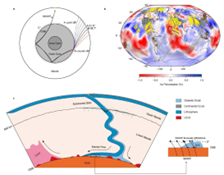Researchers from the University of Science and Technology of China (USTC), in collaboration with the Chinese Academy of Sciences and international scientists, have proposed a new method, named the SKKKP B focal extended seismic phase technique. This technique has unveiled a series of ultralow velocity zones (ULVZs) in the large high-speed anomaly region of the Earth's core-mantle boundary (CMB). The findings, published in Nature Geoscience.
The CMB is crucial for the Earth's magnetic field and rotation. It is known that this boundary harbors complex structures, including the ULVZs, characterized by significantly slowed seismic wave velocities. The origin and structure of these zones are key to unravel and understand some secrets in related fields, especially the Earth’s science.
Seismological observations indicated that ULVZs primarily reside within and around large low-velocity provinces (LLVPs), while their presence in high-velocity anomalies remains unclear. To address this, researchers introduced a novel SKKKP B focal extension seismic phase technique to detect ULVZs at the CMB.
The technique focused on analyzing the SKKKP seismic core phase—a specific pattern of wave propagation and reflection at the CMB. By conducting an in-depth analysis of SKKKP waves, researchers uncovered that the ULVZs are responsible for the unexpectedly large observable distances of these waves.
Researchers also discovered ULVZs not only around the Pacific Ocean and below Africa but also in less explored high-speed anomaly areas such as Central America, Central and Western Asia, Alaska, and Greenland.
Further explorations suggested that ULVZ formation might be linked to tectonic plate movement. As a subducting plate descends into the lower mantle, the oceanic crust of the mantle, with a lower melting point, may separate from the underlying plate and sink to the CMB, potentially leading to partial melting and ULVZ creation.

Sampling regions of SKKKP B-caustic diffractions and dynamic
processes of ULVZ evolution (Image by USTC)
The study enhances the understanding of the Earth's inner workings and underscores the importance of collaboration in scientific exploration, offering us a closer look at our mysterious planet.
paper link: https://doi.org/10.1038/s41561-024-01394-5
(Written by CHEN Yehong, edited by HUANG Rui, USTC News Center)